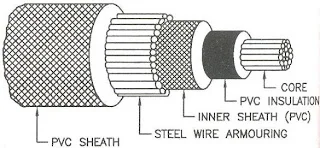Material Composition:
- XLPE Cable:
- XLPE is a thermosetting material, meaning it undergoes a chemical cross-linking process during manufacturing. This process enhances its properties, making it more durable and less susceptible to deformation under high temperatures.
- Due to cross-linking, XLPE has excellent mechanical strength and resistance to environmental factors, making it suitable for outdoor and underground applications.
- PVC Cable:
- PVC is a thermoplastic material, meaning it softens when heated and hardens when cooled, without undergoing cross-linking. It remains in a pliable state when exposed to heat, which can be a limitation in certain conditions.
- PVC cables are more flexible and easier to work with, but they lack the same level of mechanical and thermal stability as XLPE.
Temperature Rating:
- XLPE Cable:
- XLPE has a higher temperature rating, typically in the range of 90°C to 105°C. This allows it to handle higher operating temperatures without degrading, making it suitable for applications where heat resistance is essential.
- PVC Cable:
- PVC cables have a lower temperature rating, usually up to 70°C. They are not suitable for applications where high-temperature resistance is required because PVC softens and can deform when exposed to elevated temperatures.
Voltage Applications:
- XLPE Cable:
- XLPE is commonly used for higher voltage applications, including medium and high voltage power distribution systems, due to its superior insulation properties.
- PVC Cable:
- PVC cables are typically used for lower voltage applications, such as household wiring, small appliances, and low-voltage electrical systems.
Resistance to Moisture and Environmental Factors:
- XLPE Cable:
- XLPE exhibits better resistance to moisture, chemicals, and UV radiation, making it suitable for outdoor and underground installations.
- PVC Cable:
- While PVC can resist moisture to some extent, it is not as durable as XLPE in harsh outdoor or underground conditions and is more prone to environmental degradation over time.
In summary, the choice between XLPE and PVC cables depends on the specific requirements of the electrical application. XLPE is favored for high voltage, high-temperature, and outdoor installations, while PVC is preferred for lower voltage and more flexible applications.

| Factor | PVC Cable | XLPE Cable |
|---|---|---|
| Electric Load | Suitable for Regular Loads | Suitable for Greater Loads |
| Installation | Easy to Install | Slightly Tougher to Install |
| Heat Resistance | Average | Good |
| Chemical Resistance | Good | Very Good |
| Maximum Operating Temp. | 70 Degrees C | 90 degrees C |
| Short Circuit Temp. | 160 Degrees C | 250 degrees C |
| Lower Operating Temperature | -15°C for General Purpose Compounds | -400 C for XLPE Grade. |
| Health | Toxic | Neutral |
| Toughness | Good | Poor Compare to PVC |
| Cost Saving | High Cost Compare to XLPE Insulated Cable | Low Cost Compare to PVC Insulated Cabl |
| Factor | PVC Cable | XLPE Cable |
|---|---|---|
| Electric Load | Suitable for Regular Loads | Suitable for Greater Loads |
| Installation | Easy to Install | Slightly Tougher to Install |
| Heat Resistance | Average | Good |
| Chemical Resistance | Good | Very Good |
| Maximum Operating Temp. | 70 Degrees C | 90 degrees C |
| Short Circuit Temp. | 160 Degrees C | 250 degrees C |
| Lower Operating Temperature | -15°C for General Purpose Compounds | -400 C for XLPE Grade. |
| Health | Toxic | Neutral |
| Toughness | Good | Poor Compare to PVC |
| Cost Saving | High Cost Compare to XLPE Insulated Cable | Low Cost Compare to PVC Insulated Cabl |


